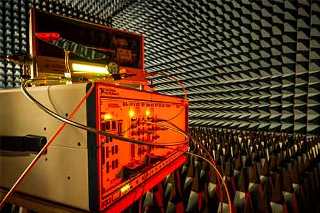May 20 2015
Radio systems, such as mobile phones and wireless internet connections, have become an integral part of modern life. However, today’s devices use twice as much of the radio spectrum as is necessary. New technology is being developed that could fundamentally change radio design and could increase data rates and network capacity, reduce power consumption, create cheaper devices and enable global roaming.
 Novel full-duplex transceiver in the anechoic chamber. Image credit: Sam Duckerin
Novel full-duplex transceiver in the anechoic chamber. Image credit: Sam Duckerin
A pioneering team of researchers from the University of Bristol's Communication Systems and Networks research group, have developed a new technique that can estimate and cancel out the interference from one’s own transmission, allowing a radio device to transmit and receive on the same channel at the same time. This therefore requires only one channel for two-way communication, using half as much spectrum compared to the current technology.
Leo Laughlin, a PhD student from the University’s EPSRC Centre for Doctoral Training (CDT) in Communications, together with MSc student Chunqing Zhang, supervisors Professor Mark Beach and Dr Kevin Morris, and industrial mentor, Dr John Haine at u-blox, have designed and built a novel full-duplex transceiver architecture, which combines electrical balance isolation and active radio frequency cancellation. Their prototype can suppress interference by a factor of over 100 million and uses low-cost, small form factor technologies, making it well suited to use in mobile devices such as smartphones and tablets.
This important change in radio design could offer a range of benefits. In Wi-Fi systems this would double the capacity of a Wi-Fi access point, allowing more users and higher data rates. For cellular systems, full-duplex operation would also deliver increased capacity and data rates, or alternatively the network operators could provide the same total network capacity with fewer base station sites, giving obvious benefits in the cost and environmental impact of running the network.
Leo Laughlin, who is in the first cohort of students in the CDT in Communications, said: “Until now there has been a fundamental unsolved problem with radio communication. Since the radio spectrum is a limited resource, and with network operators paying billions of pounds to access the spectrum, solving this problem would bring us one step closer to the faster, cheaper and greener devices of our connected future.”
As well as being part of the evolution to 5G mobile, this research is also very relevant to the design of the radio circuitry in current 3G and 4G cellular mobile devices. In today’s mobile devices, a separate filtering component is required for each frequency band, and because of this, today’s mobiles phone do not support all of the frequency channels which are in use across the world. Different devices are manufactured for different regions of the world, and there are currently no 4G phones capable of unrestricted global roaming. Replacing these filters with the research team’s duplexer circuit would create smaller and cheaper devices, and would allow manufacturers to produce a single model for the entire world. This would enable global roaming on 4G and would further decrease cost through greater economies of scale.
Mark Beach, Professor of Radio Systems Engineering, commented: “In addition to EPSRC’s investment in Doctoral Training Centres at Bristol, we have also been awarded equipment funding. Leo and Chunqing have taken full advantage of the new laboratory facilities in the validation and optimisation of our full-duplex architecture.”
The team have published papers about their research in the IEEE Journal on Selected Areas in Communications special issue on full duplex radio, and in this month’s issue of the IEEE Communications Magazine, and patents have been filed to protect the novel duplexer design.
Paper:
Electrical balance duplexing for small form factor realization of in-band full duplex by Leo Laughlin, Mark A. Beach, Kevin A. Morris, and John L. Haine in IEEE Communications Magazine.
Paper:
Optimum single antenna full duplex using hybrid junctions by Leo Laughlin, Mark A. Beach, Kevin A. Morris and John L. Haine in IEEE Journal on Selected Areas in Communications.